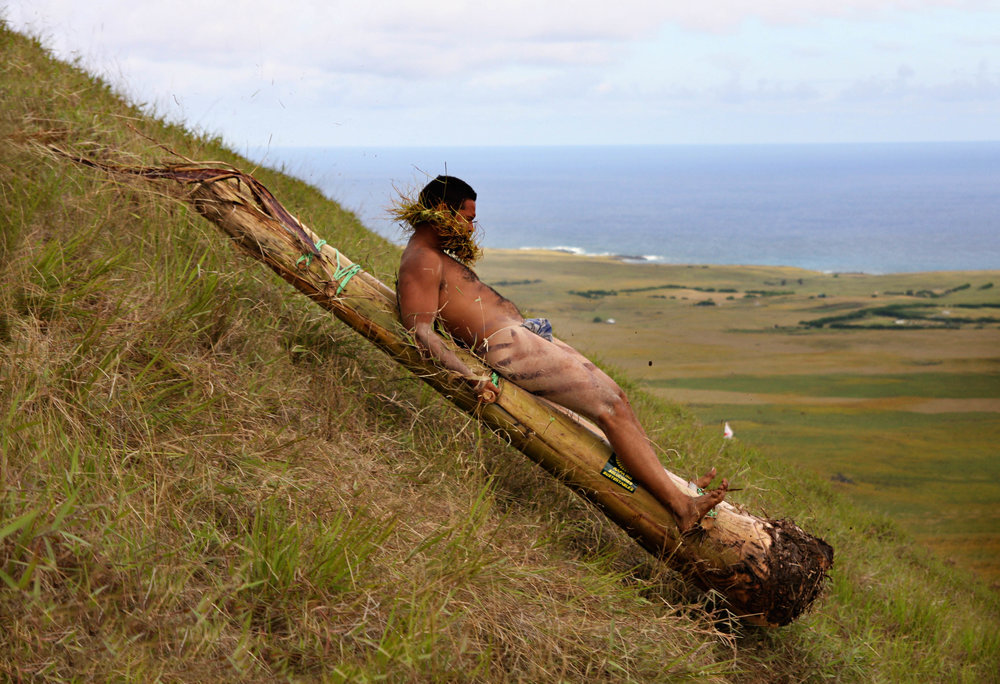
Haka Pei (Easter Island, Chile)
- Name of sport (game): Haka Pei
- Name in native language: Haka Pei
- Place of practice (continent, state, nation):
Easter Island
- History:
A cultural tradition that developed on the island long ago occurred when a youth wanted to prove to his clan that he was no longer an adolescent and should be considered an adult and a warrior. That tradition was the famous "Haka Pei" test.
This involved hurtling down the side of a volcano riding on a banana-trunk sled. The volcano used for this test of speed and nerves was either Maunga Tangaroa or Manga Otuhu. The Pascuans (Easter Islanders) very knowledgeable about their culture note that this test began on the slopes of the sacred volcano, Rano Raraku, and the mountain Pu Makari.
At the same time, the Pascuans had another version of "Haka Pei". This version believes that the haka pei was part of the training of warriors in order to become brave to fight the other clans of the island. This was called "Ma’ari". Future warriors were supposed to slide as fast as possible along a cord several kilometers long that connected a volcano summit with a sacred rising point in the valley. Old timers say this harrowing test was conducted between two volcanoes - Pu Makari and Maunga To’uto’o, or between the summit of Pu Makari and the Tongariki platform. - Description:
Competitors choose banana trunks making them strong and thick to support the competitor's weight and friction with the grass. Then they transport them to the base of the hill and leave them for a few days so that the trunks absorb the energy of the place. Before the test, the trunks are mounted at the top of the hill with the help of a pulley, are cut with a machete then are tied with ropes and stakes. The day before, the competitors participating for the first time go to the Church of Santa Cruz to pray. Before the start, the competitors stand in a circle and pray maké maké (deity of Easter Island) to obtain the mana (spiritual power) which protects them, an umu tahu (local curanto) honors the ancestors who practiced haka pei and blessed the current competitors.
The "Haka Pei" event has place on the 35-degree slopes of the volcano Maunga Pu’i. Competitors must descend the hill on two banana trunks linked together, the goal being to get as far as possible by being the fastest. The hill measures 120 meters and is inclined at 45 °, the descent is about 300 meters and the competitors can reach 80 km / h. They are dressed in a hami (loincloth) and takona (traditional painting using ki'ea, natural pigment). During the event, spectators eat an umu tahu.
All along the 600-meter (1,969-foot) course down the volcano slope, there is a judge every 100-meters (328 feet) using a stopwatch to help accurately calculate the speed of each contestant. The winner is not the one who reaches the fastest speed, but the one who makes the descent in the fastest time.
Some practice the haka pei tandem which consists of going down two on the trunks, which doubles the weight and increases the speed.
The haka pei is a dangerous sport, only about twenty rapa nui take the risk of participating in it. There are regular accidents.
According to tradition, the gods always demand sacrifices before a Haka Pei test is held. So two white chickens cover the "cost" of the Umu Tahu tradition. Such sacrifices are still routinely practiced for all-important activities that highlight the contemporary lives of today’s Pascuans.
Once the Haka Pei test ends for another year, the gods must be thanked for those left to live. So an "Umu Hatu" is organized, offering the gods food, such as sweet potatoes and yams. - Current status:
Today, the haka pei takes place on Maunga Pu'i hill during the Tapati Festival. As a result of many accidents, the ancient test of manhood was forbidden for two years, from 1990-1991.
Today, participants of Haka Pei riske their lives and bones on the slopes of the Maunga Pu’i volcano to maintain the tradition, but also to win a cash prize of around 770 USD. - Importance (for practitioners, communities etc.):
The "Haka Pei" was revived from a cultural graveyard in 1981 by a handful of culturally motivated islanders, including two Pascuans—Maea Puhi and Hucke Atan.
The "Haka Pei" takes place during the Tapati Rapa Nui Festival, the traditional celebration held each year during the first two weeks of February. - Sources of information :
Place of Haka Pei competitions - https://www.360cities.net/image/111-easter-island-haka-pei
Articles:
https://imaginaisladepascua.com/haka-pei/
https://prezi.com/0i8mo3qsjscz/haka-pei/Video:
https://www.youtube.com/watch?v=h5-qQybEc14
https://www.youtube.com/watch?v=CuMS_xZHzIgSource of photos in this article:
https://imaginaisladepascua.com/en/haka-pei-the-extreme-sport-of-easter-island/; https://odkrywcy-swiata.pl/?p=647; https://galapagostravel.online/tapati-festival; https://tambotravel.com/blog/tapati-festival-easter-island-traditions-and-culture/; https://pt.travel2w.com/3735-the-worlds-strangest-sports; - Gallery:

